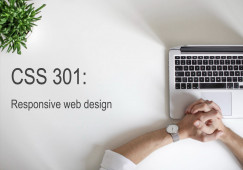Welcome to CSS 301: Responsive web design
This is the “final step” when learning CSS: how to make your website “responsive”.
Making a website responsive is the act of writing code that makes your website look good on TVs, desktops, laptops, tablets, and phones.
Typically we write one codebase to support all these different device types.
The problem with normal CSS is, for example, an image could be 500 pixels wide.. but what if a viewer with a phone only has a 425 pixel wide device? Now your website looks broken. That is no good.
Responsive web design is the act of making your HTML elements “snap” to different locations and to look different on different devices.
In this course, you will use your knowledge of background colors, border radii, font colors, flexbox, and grid to start making a web page act responsively.
Lastly, you will finish this course by creating a page layout using flexbox (alternatively you can use CSS grid) and making the template responsive: that is, you will make it “mobile friendly” so when you shrink down your browser size, it looks great on tablets and phones.





There are no reviews yet.